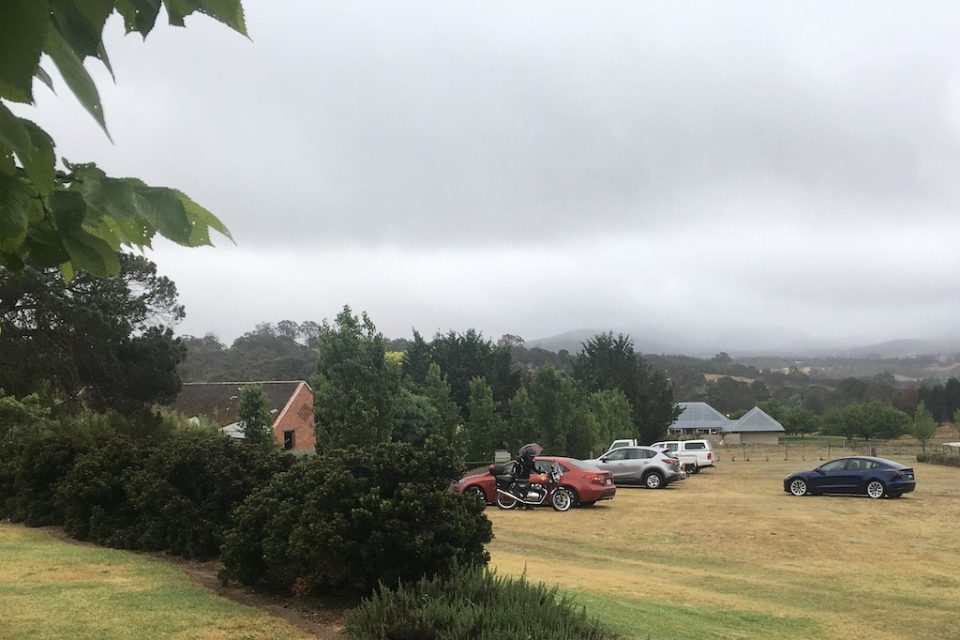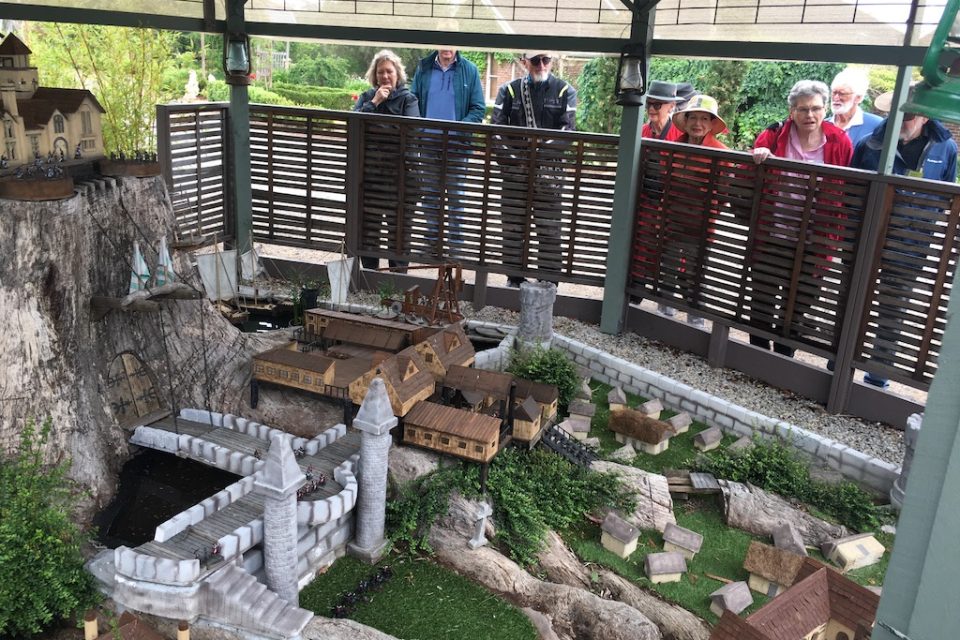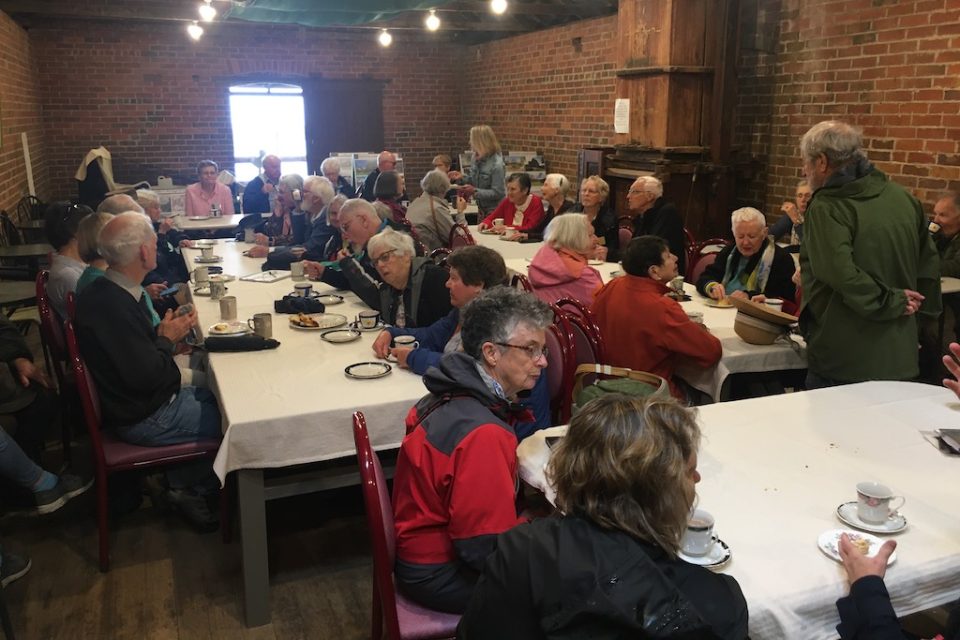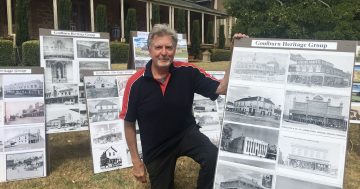
Forty-six members of the Australian Garden History Society in Canberra strolled through historic Kentgrove Gardens on Friday morning, one of many tours this spring to come to Goulburn. Coaches have come too and are a boon to a local nursery. Photo: John Thistleton.
Unlike neighbouring towns, Goulburn has no formal open garden scheme, but that has not stopped one historic property with exceptional gardens accidentally finding itself on the tour circuit, with spectacular results.
Goulburn’s potential for open gardens became evident years ago when a coach from South Australia unexpectedly turned up at Kentgrove on the city’s northern fringe with passengers keen to explore former nurseryman Doug Rawlinson’s gardens.
An even bigger stream of visitors followed later when a woman from Botanica Tours in Melbourne published a two-page spread featuring the different gardens, including an undercover rainforest in Garden Clubs of Australia’s magazine. Other garden clubs read it and began booking tours of Kentgrove.
Coaches and cars from Canberra, Sydney and Mittagong garden clubs, and others travelling through from South Australia and Queensland, have all popped into Kentgrove this spring. Some followed up with a stop at Gehl Garden Centre before returning home.
Gehl’s owner Sally Nelson said the visitors stocked up on veggie seedlings, lots of potted colour, and almost anything except for trees because they did not have room to take them home.
“One coach was loaded up to the hilt,” Sally said.
Last Friday, 46 members of the Australian Garden History Society in Canberra came in their cars. Happily gathering in the sprinkling mist across from stables, tack room and groom’s quarters, they enjoyed a gentle valley view unfolding beneath them and a foggy horizon in the distance.
They lingered over a miniature medieval castle carved and crafted into the dead trunk of a giant blue gum, and a Japanese garden and tea house with a bubbling fountain, frog-and-fish-filled pool and delicate maples.
“Maybe weeds don’t grow in Goulburn,” one of the gardening enthusiasts remarked, astonished on hearing Kentgrove has one gardener, Doug, who has just one volunteer to help host the tours, Mhairi Fraser.
The tour wended through a new drop-down garden designed for birds, bees and butterflies, then across the sweeping lawns and clipped hedges at the front of Kentgrove homestead and then around raised beds of the kitchen herb garden built on an old tennis court.
“Being a gardener, you would know one of the best things is to share what you’ve got,” Doug told his visitors, leading them past his knot garden of curving hedges into the former jam factory and startling them again with stories about Kentgrove’s history.
Supported by 30,000 trees and produce from neighbours, the Argyle Jam Factory exported jam to England and had a cherry adjudged in 1893 to be the world’s biggest with a nine-metre drip line.
More astonishing, perhaps, was Kentgrove’s connection to Doug’s family. Applying for a job a generation ago, his father, Harry Rawlinson, spent more than a week riding his pushbike 380 kilometres from Cootamundra to Sydney to apply, only to learn the position was filled. Standing nearby, a wealthy property owner, Ernie Hyles, heard Harry’s misfortune and offered him a job at Uriarra sheep station in Canberra.
Harry and the family later transferred to Hyles’s other property, Kentgrove, which became Doug’s childhood playground.
Kentgrove was later sold to pay for Hyles’s wife’s death duties, then subsequent owner the Gittoes family bought the property, including its rundown homestead, which they restored and repaired, spending four times the purchase price to bring it up to standard.
“All through my adult life I thought I would get Kentgrove back one day,” Doug said. That came in 2006 when it was a drought-ravaged dustbowl, which he has transformed into an irrigated tourist attraction.
Garden club leader Nancy Clarke, who went to high school in Goulburn, thanked Doug for a fascinating morning and announced historic Riversdale was the next property on the group’s stopover.





These substantial gardens’ popularity underlines a fresh strategy that has been drawn up for Goulburn to join an open garden scheme. Well researched and compiled by a person who wishes to remain anonymous, the plans suggest spring or autumn would be suitable when deciduous trees put on a fiery-coloured display – or both seasons.
Open gardens can enhance public gardens and spaces in the heritage city, promote Goulburn and raise awareness and appreciation of the city’s horticultural and cultural riches. Such a scheme would encourage the conservation of significant landscapes, historic buildings and gardens, and complement the Lilac Time Festival.







